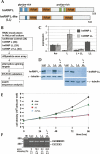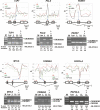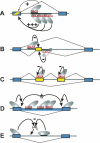Diverse roles of hnRNP L in mammalian mRNA processing: a combined microarray and RNAi analysis
- PMID: 18073345
- PMCID: PMC2212255
- DOI: 10.1261/rna.725208
Diverse roles of hnRNP L in mammalian mRNA processing: a combined microarray and RNAi analysis
Abstract
Alternative mRNA splicing patterns are determined by the combinatorial control of regulator proteins and their target RNA sequences. We have recently characterized human hnRNP L as a global regulator of alternative splicing, binding to diverse C/A-rich elements. To systematically identify hnRNP L target genes on a genome-wide level, we have combined splice-sensitive microarray analysis and an RNAi-knockdown approach. As a result, we describe 11 target genes of hnRNP L that were validated by RT-PCR and that represent several new modes of hnRNP L-dependent splicing regulation, involving both activator and repressor functions: first, intron retention; second, inclusion or skipping of cassette-type exons; third, suppression of multiple exons; and fourth, alternative poly(A) site selection. In sum, this approach revealed a surprising diversity of splicing-regulatory processes as well as poly(A) site selection in which hnRNP L is involved.
Figures








Similar articles
-
Crosslinking-immunoprecipitation (iCLIP) analysis reveals global regulatory roles of hnRNP L.RNA Biol. 2014;11(2):146-55. doi: 10.4161/rna.27991. Epub 2014 Feb 7. RNA Biol. 2014. PMID: 24526010 Free PMC article.
-
HnRNP L-mediated regulation of mammalian alternative splicing by interference with splice site recognition.RNA Biol. 2010 Jan-Feb;7(1):56-64. doi: 10.4161/rna.7.1.10402. Epub 2010 Jan 21. RNA Biol. 2010. PMID: 19946215
-
Mechanistic control of carcinoembryonic antigen-related cell adhesion molecule-1 (CEACAM1) splice isoforms by the heterogeneous nuclear ribonuclear proteins hnRNP L, hnRNP A1, and hnRNP M.J Biol Chem. 2011 May 6;286(18):16039-51. doi: 10.1074/jbc.M110.204057. Epub 2011 Mar 11. J Biol Chem. 2011. PMID: 21398516 Free PMC article.
-
Auto- and cross-regulation of the hnRNP L proteins by alternative splicing.Mol Cell Biol. 2009 Mar;29(6):1442-51. doi: 10.1128/MCB.01689-08. Epub 2009 Jan 5. Mol Cell Biol. 2009. PMID: 19124611 Free PMC article.
-
Global analysis of mRNA splicing.RNA. 2008 Feb;14(2):197-203. doi: 10.1261/rna.868008. Epub 2007 Dec 14. RNA. 2008. PMID: 18083834 Free PMC article. Review.
Cited by
-
An unbiased proteomics approach to identify human cytomegalovirus RNA-associated proteins.Virology. 2015 Jul;481:13-23. doi: 10.1016/j.virol.2015.02.008. Epub 2015 Mar 9. Virology. 2015. PMID: 25765003 Free PMC article.
-
Structural basis of the interaction between SETD2 methyltransferase and hnRNP L paralogs for governing co-transcriptional splicing.Nat Commun. 2021 Nov 8;12(1):6452. doi: 10.1038/s41467-021-26799-3. Nat Commun. 2021. PMID: 34750379 Free PMC article.
-
The transcriptional complex between the BCL2 i-motif and hnRNP LL is a molecular switch for control of gene expression that can be modulated by small molecules.J Am Chem Soc. 2014 Mar 19;136(11):4172-85. doi: 10.1021/ja4109352. Epub 2014 Mar 7. J Am Chem Soc. 2014. PMID: 24559432 Free PMC article.
-
Multilevel Differential Control of Hormone Gene Expression Programs by hnRNP L and LL in Pituitary Cells.Mol Cell Biol. 2018 May 29;38(12):e00651-17. doi: 10.1128/MCB.00651-17. Print 2018 Jun 15. Mol Cell Biol. 2018. PMID: 29610151 Free PMC article.
-
Mechanisms of alternative splicing regulation: insights from molecular and genomics approaches.Nat Rev Mol Cell Biol. 2009 Nov;10(11):741-54. doi: 10.1038/nrm2777. Epub 2009 Sep 23. Nat Rev Mol Cell Biol. 2009. PMID: 19773805 Free PMC article. Review.
References
-
- Ast, G. How did alternative splicing evolve? Nat. Rev. Genet. 2004;5:773–782. - PubMed
-
- Bilbao, D., Valcarcel, J. Getting to the heart of a splicing enhancer. Nat. Struct. Biol. 2003;10:6–7. - PubMed
-
- Black, D.L. Mechanisms of alternative pre-messenger RNA splicing. Annu. Rev. Biochem. 2003;72:291–336. - PubMed
Publication types
MeSH terms
Substances
LinkOut - more resources
Full Text Sources
Other Literature Sources
Molecular Biology Databases
Research Materials
